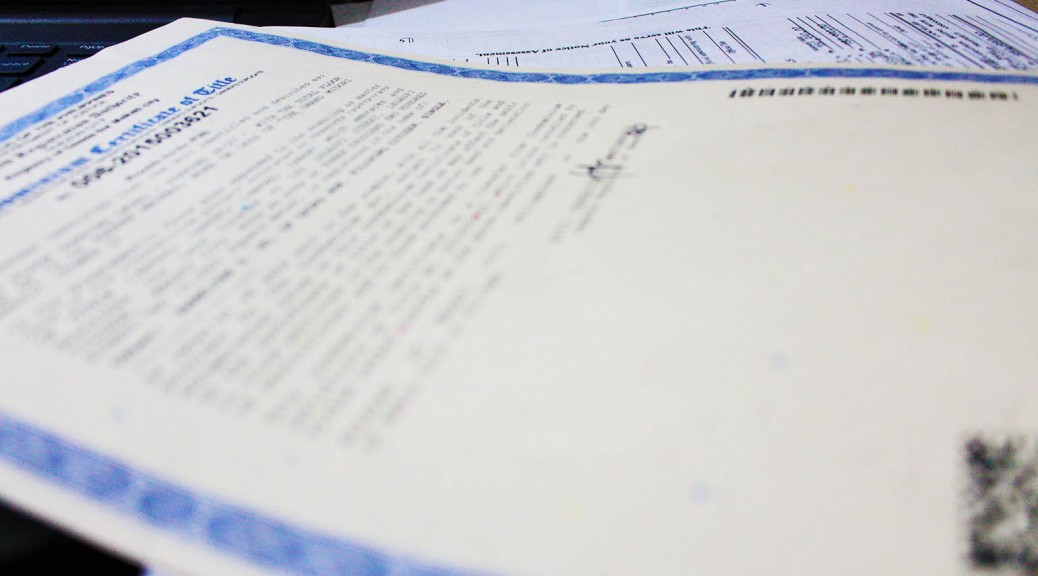
How to Transfer Real Estate Titles in the Philippines (From a Sale)
Too often, when there’s a problem with the documents of a piece of land, it can be traced back to an improper transfer of ownership. And this simple mistake is the root cause of very long court proceedings in a lot of cases.
When the Title to a property is not properly transferred to the the new owner, it likely becomes a cause of conflicting claims in the future. It costs a lot of resources — not only money, but also time and energy — to resolve this when a long period of time has already passed.
Situations you don’t want to get into
Below are some problematic situations we’ve seen from previous and existing clients. And I’m sure you don’t want to get into any one of them, so I recommend reading the rest of this post. 🙂
-
A sale of a property between two strangers. They only executed a Deed of Absolute Sale but the buyer did not proceed to transfer the Title to his name. The sale was not even registered with the Registry of Deeds.
Many years later, the buyer died and his children assumed ownership of the property, also without completely processing the transfer of Title.
When the seller also died, his children settled his estate. Included in there was the property already sold to the abovementioned buyer. A new Title was released for the property, in the name of one of the seller’s children.
There are now conflicting claims between the children of the seller and the children of the buyer.
-
A Transfer Certificate of Title issued to a person without complete supporting documentations. It turned out that this new Title was issued with the help of an insider “contact” or “connection” from the concerned government agency. But the supporting documents are lacking.
A buyer bought the property relying on the authenticity of the said Title. Now, when he tried to transfer it to his name, the supporting documents for the previous transfer were required. They are nowhere to be found, so… big problem.
(Sidenote: This is why an independent Title Verification is very important before buying a property from an individual seller.)
-
A sale of a property by a corporation to an individual buyer. After completing his payment, the buyer did not proceed to complete the transfer of the Title to his name. The Deed of Sale was not registered and not even notarized.
Years later, the corporation dissolved. Now the buyer wants to process the transfer of Title to his name. But in getting the Deed of Sale notarized, nobody can sign the documents in behalf of the corporate seller because the corporation is not existing anymore. Again, a big problem.
We have some more examples of these troubled situations involving real property Titles. But the above should be enough to give you an idea of how important it is to transfer Titles properly.
So, below is a practical and step by step guide on how to properly process a transfer of Title subsequent to a sale.
Important note: There are several different modes of transferring ownership of a real property. It can be through a sale, donation, exchange, inheritance, and others that are more complicated. Each of these modes has different sets of documentary requirements. The one I’ll be describing here is for a sale.
The Proper and Complete Process
I. Preparation
-
Prepare the necessary documents for execution of Deed of Sale:
- Deed of Absolute Sale (or other variants, as appropriate in your case)
- Acknowledgment of Payment (from buyer to seller)
- Affidavit of non-tenancy and/or no pending case (as appropriate)
- Affidavit of land holdings by the buyer (as applicable)
-
Signing of documents.
Both parties should sign the following:
- Deed of Absolute Sale
- Acknowledgment Receipt of Payment by the buyer to seller
The seller should sign the:
- Affidavit of non-tenancy and/or no pending case
The buyer should sign the:
- Affidavit of land holdings
-
Secure the following documents to be needed later:
- 2 government-issued ID’s of both the seller and the buyer
- Tax Identification Number (TIN) of each party
- Original Owner’s duplicate of Title
- Marriage contract, if applicable
- Previous Certificate Authorizing Registration (CAR)
- Tax declaration
- Receipt(s) of Real Property Tax (RPT) payments
- Special Power of Attorney (SPA), if dealing with an attorney-in-fact (an authorized representative)
-
Notarization of documents – all documents signed by the parties should be notarized.
II. Secure payment computations and certified copies of the following documents.
-
Bureau of Internal Revenue (BIR):
- Secure computation of fees for Documentary Stamp Tax (DST) and for
- Capital Gains Tax (CGT)
Notes: Go to ONETT for DST and CGT computation; ask for the specific payee to be named in the manager’s check (if paying in check); and take note of their accredited banks, so you’ll know where to submit the payments.
-
City (or Municipal) Treasurer’s Office:
- Secure computation of Transfer Tax
- Secure Tax Clearance
Notes: Ask for computation of the Transfer Tax; ask for the specific payee to be named in the manager’s check for payment (if paying in check).
-
City (or Municipal) Assessor’s Office:
- Secure Certified True Copy of the Tax Declaration
-
Registry of Deeds:
- Secure computation of Registration Fee
- Secure Certified True Copy of the existing Transfer Certificate of Title (TCT) or Condominium Certificate of Title (CCT), as appropriate
Notes: Ask for computation of the Registration Fee; ask for the specific payee to be named in the manager’s check for payment (if paying in check).
III. Preparation of payments.
Now that you know the exact fees that you will have to pay, you should prepare these amounts. These fees are preferrably paid using manager’s checks. But you can also pay them in cash.
Take note of the following deadlines for the settlement of these fees.
-
BIR:
- CGT – 30 days after the date of notarization of the Deed of Sale
- DST – 5th day of the following month from notarization of the Deed of Sale
-
City Treasurer’s Office:
- Transfer Tax – 60 days from date of execution of Deed of Sale or the Acknowledgment of Payment
-
Registry of Deeds:
- Registration Fee – 1 year from the date of release of CAR from BIR + 6 months extension if approved by BIR upon due submission of request
IV. Process payments to BIR.
-
Present the following requirements to ONETT to obtain the official Computation Sheet:
- Certified True Copy of the Title (TCT or CCT)
- Certified True Copy of the Tax Declaration
- IDs of the buyer(s) and the seller(s)
- TIN of the buyer(s) and the seller(s)
- Filled-out online DST & CGT BIR Forms
- Deed of Sale
- Acknowledgment of Payment
-
Pay the DST & CGT at the Accredited Agent Bank (AAB) of the BIR-RDO (Revenue District Office)
- Fill out the bank form for the BIR payments
- Present the verified DST & CGT BIR returns together with the MCs (or cash payment) and the bank form
- Don’t forget the transaction slip!
-
Then go back to BIR to file the above listed documents together with the transaction slip for the processing of the new CAR
V. Process payment to the City Treasurer.
-
Present the following requirements to the Officer in Charge (OIC):
- Deed of Sale
- IDs of the buyer(s) and the Seller(s)
-
Submit manager’s check or cash payment to the designated cashier.
-
Bring the receipt to the OIC together with the above mentioned documents to process the Transfer Tax Clearance.
VI. Process payment to the Registry of Deeds.
-
Fill out an application form for transfer of Title and present the following requirements to the Examiner of the Day:
- CAR from the BIR
- Deed of Sale
- Transfer Tax Clearance
-
Submit the manager’s check or cash payment to the cashier for the registration. Then attach the receipt to the application form together with the documents stated above.
VII. Follow up with the Registry of Deeds.
-
Contact the assigned examiner for the progress of your application for new Title.
-
Once the new title has been released, file a copy with the City Assessors’ Office.
VIII. New Tax Declaration.
-
Finally, when the new Title under the buyer’s name is already released, present it to the Assessors’ Office for the issuance of the new Tax Declaration.
-
Congratulations! You’ve now completed the proper transfer of Title.
Parting Reminders
Great care and attention to small details are required in this process. You are also going to need a lot of patience as this will involve a lot of waiting and sometimes long queues.
Little mistakes along the way may cause major delays and possible serious issues in the future. So please be careful to save yourself a lot of trouble. If there’s anything you are not sure about, ask questions to relevant persons, not just to anyone.
Also, if you’re in doubt as to whether an original or only a copy of a document is required, just bring the original. You can just make copies there if only copies are needed.
Would you rather have professionals do this Title Transfer for you? Contact us today and experience our award-winning services and client support that will save you tons of headaches along the way.
See how we can help you with Titles today →
-
Jhon Niceman
-
JefferyRussel69013
-
sam samson
-
Hunky Guy16
-
Jen Jen
-
-
Sniperer Alertoo
-
Andrey Bobby B. Safronov
-
Jen Jen
-
-
Jo Ram
-
Nelly Wong
-
Nimrod Flores
-
Nelly Wong
-
Nimrod Flores
-
Nelly Wong
-
Nimrod Flores
-
-
-
-
-
jjpau
-
Nimrod Flores
-
-
Miles Valencia
-
Nimrod Flores
-
Miles Valencia
-
IMHO 101
-
-
Rabih Waked
-
-
-
Rabih Waked
-
Nimrod Flores
-
Rabih Waked
-
IMHO 101
-
-
-
arlene morimoto
-
Rabih Waked
-
IMHO 101
-
-
-
-
Jay Escalera Bahulay
-
Caloy
-
Erwin Resultay
-
IMHO 101
-
-
Teody Foulkes
-
IMHO 101
-
Lilibeth Quiambao
-
Raiza Tulan
-
-
-
ma. ohnor Mestre
-
arlene morimoto
-
IMHO 101
-
-
Clydee Ayeng
-
Nimrod Flores
-
-
Ellen Calisang
-
IMHO 101
-
-
Jescel Degamo
-
IMHO 101
-
-
Lorraine Ventura-Visco
-
Kenshin Mangune
-
Frederick Dy
-
-
sheng
-
teokun
-
Manjur Sarder
-
Frederick Dy
-
-
Darlyn Atasha Viado
-
Mary Nitchie Ko
-
Darlyn Atasha Viado
-
-
-
菊地 クシ 愛
-
菊地 クシ 愛
-
菊地 クシ 愛
-
Karl Mark Engo
-
Jen Jen
-
-
RudMax Lee Tipolo
-
IMHO 101
-
-
Margie Dela Cruz
-
Mary Nitchie Ko
-
-
Sheryll Pe
-
IMHO 101
-
-
Aly
-
IMHO 101
-
-
Rose Guadalquiver Asedilla
-
IMHO 101
-
-
Aleta Pau
-
IMHO 101
-
pauline patrimonio
-
Nimrod Flores
-
pauline patrimonio
-
-
-
-
-
Louie Matias Juanica
-
IMHO 101
-
-
Doc Tina
-
IMHO 101
-
-
Mary Ann Ventura
-
IMHO 101
-
-
Maricel Faith Halfway
-
IMHO 101
-
-
Katie Trinidad
-
IMHO 101
-
-
ivan cliff
-
IMHO 101
-
-
Lester Ryan Elcana
-
IMHO 101
-
Lester Ryan Elcana
-
IMHO 101
-
Lester Ryan Elcana
-
-
-
-
-
JoBi JoBi
-
IMHO 101
-
-
Maya Eleria
-
IMHO 101
-
hyperjigz
-
IMHO 101
-
-
-
-
Janice Picardal
-
IMHO 101
-
Janice Picardal
-
IMHO 101
-
Janice Picardal
-
IMHO 101
-
-
-
-
-
Alyson Lim
-
IMHO 101
-
-
Ruth Santiago Aguilar
-
IMHO 101
-
Mega Star
-
-
Mains
-
IMHO 101
-
Mains
-
Mains
-
Mains
-
IMHO 101
-
IMHO 101
-
-
-
-
Mega Star
-
-
MARK ADRIAN E. CELESTE
-
Mega Star
-
-
Mike Baydal
-
IMHO 101
-
-
PhatB01
-
IMHO 101
-
PhatB01
-
IMHO 101
-
PhatB01
-
IMHO 101
-
PhatB01
-
-
-
-
-
Rebeca Lumang
-
IMHO 101
-
Rebeca Lumang
-
-
-
Arty V.
-
LC Acuna
-
-
Anabelle Yalung
-
IMHO 101
-
-
Ann Donovan
-
Jen Jen
-
-
Phil Sopo Tacio
-
Tin Datinguinoo
-
Delia Marie Michael
-
Marlon Martin
-
Frederick Dy
-
-
Marlon Martin
-
Nimrod Flores
-
-
Vernice zuleta
-
Nimrod Flores
-
-
Edward G.S.
-
Nimrod Flores
-
-
godspeed godspeed
-
Nimrod Flores
-
-
Katherine Gozum
-
Nimrod Flores
-
Abegail Peñaranda
-
Jen Jen
-
John Kenneth Joaquin
-
-
-
-
-
Mamontostado
-
Nimrod Flores
-
Mamontostado
-
Nimrod Flores
-
-
-
-
Aldren Lustina
-
Frederick Dy
-
-
Jacielle Park
-
Frederick Dy
-
Nimrod Flores
-
MyMmy Megs
-
MyMmy Megs
-
-
-
Marie Thess
-
Frederick Dy
-
-
Regina Boy
-
Sophia Ann Suarez
-
Nancy Hill
-
Nimrod Flores
-
Tirzy
-
-
-
Concern
-
Angelo Quiambao
-
Nimrod Flores
-
Angelo Quiambao
-
Nimrod Flores
-
-
-
-
Tirzy
-
Tirzy
-
Jen Jen
-
-
JimPat Antonio
-
Rene Panorel
-
Anna Mae Roxas
-
melvin solon
-
Dee Gee
-
AL Angeles
-
Chel A.
-
Carl Dominic Bueno
-
Kimberly Erlanda
-
Jen Jen
-
-
Jj
-
Jhespol Jhespol
-
Maya
-
Frederick Dy
-
-
Junjun Suganob
-
Ophelia Oliveros
-
Frederick Dy
-
Ophelia Oliveros
-
Rodney
-
-
-
Shiera Aniceto
-
Maddie N Chelsea
-
Nerissa Panaligan
-
Nerissa Panaligan
-
Frederick Dy
-
-
AJSB Channel
-
Frederick Dy
-
-
Kristina David
-
Frederick Dy
-
-
Vernal Lim
-
kate leung
-
Remie Valeriano
-
rose eduardo
-
J Sale
-
Frederick Dy
-
-
Kayi Montesa
-
Sheena Peron
-
Frederick Dy
-
-
Rodney
-
Frederick Dy
-
-
Joycelyn R. Lopez
-
Jen Jen
-
-
Jovel Acedera
-
Frederick Dy
-
-
Roy C. Flores
-
kim
-
Frederick Dy
-
-
Bob ng
-
Frederick Dy
-
-
Ester Ling
-
Frederick Dy
-
-
Antonieta Moralde Dublin
-
Adea IsI
-
Angelo
-
Anz VF
-
Frederick Dy
-
-
Clare Ramirez
-
Frederick Dy
-
Iyang Papabutt
-
-
-
Ven Tan
-
Fer Lyn
-
Frederick Dy
-
-
Marjorie Derez – Torres
-
Frederick Dy
-
-
Jacq Saavedra
-
wendz
-
hilda javier
-
Moy
-
Heinrich Glennon Villasis
-
Edgar Jabas
-
Kristine Laguros
-
Yoh
-
elizabeth mengote
-
Armando Angelita Ambrocio
-
trina
-
Susan
-
Charliemar Ramada
-
Diane Correa
-
Marites valdez
-
John
-
Rem Ricaforte
-
Rem Ricaforte
-
Nieva Rica Plaza Chua
-
Devy
-
Ronaldo Gutierrez













